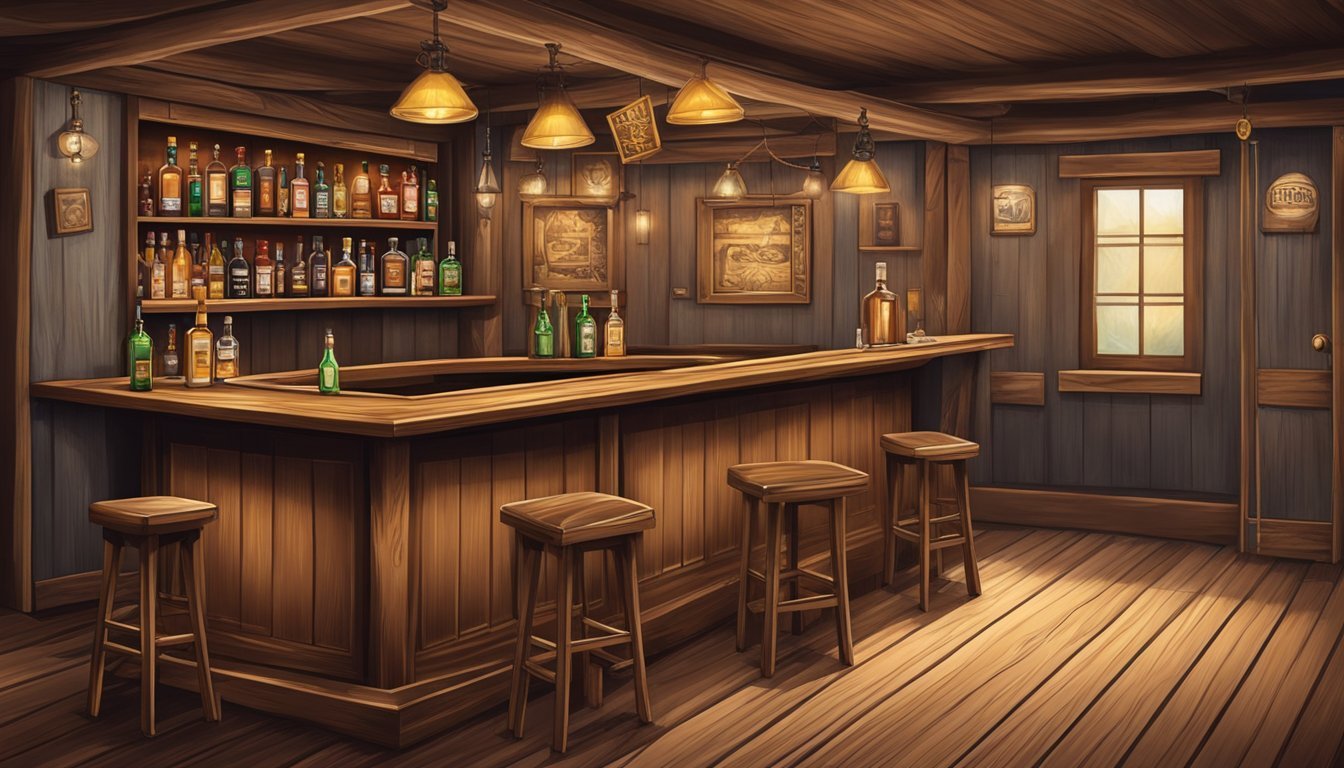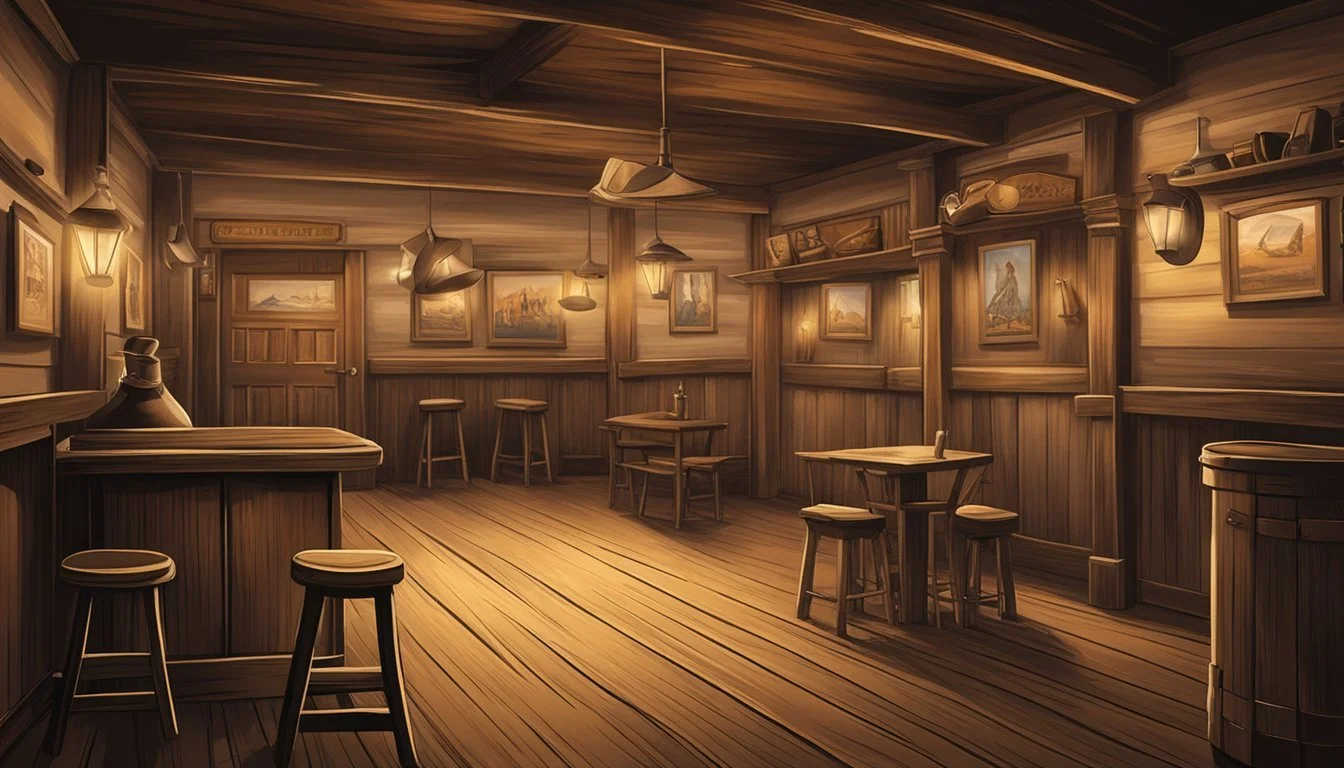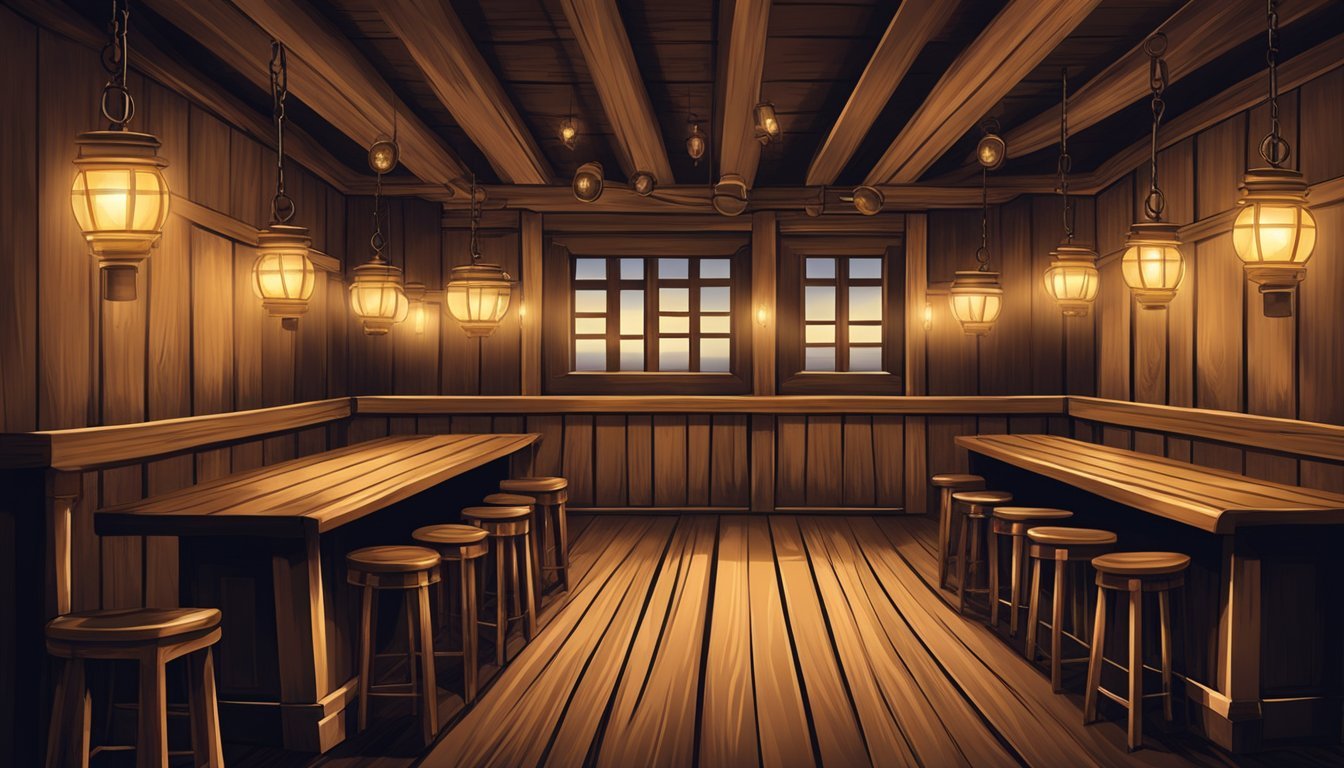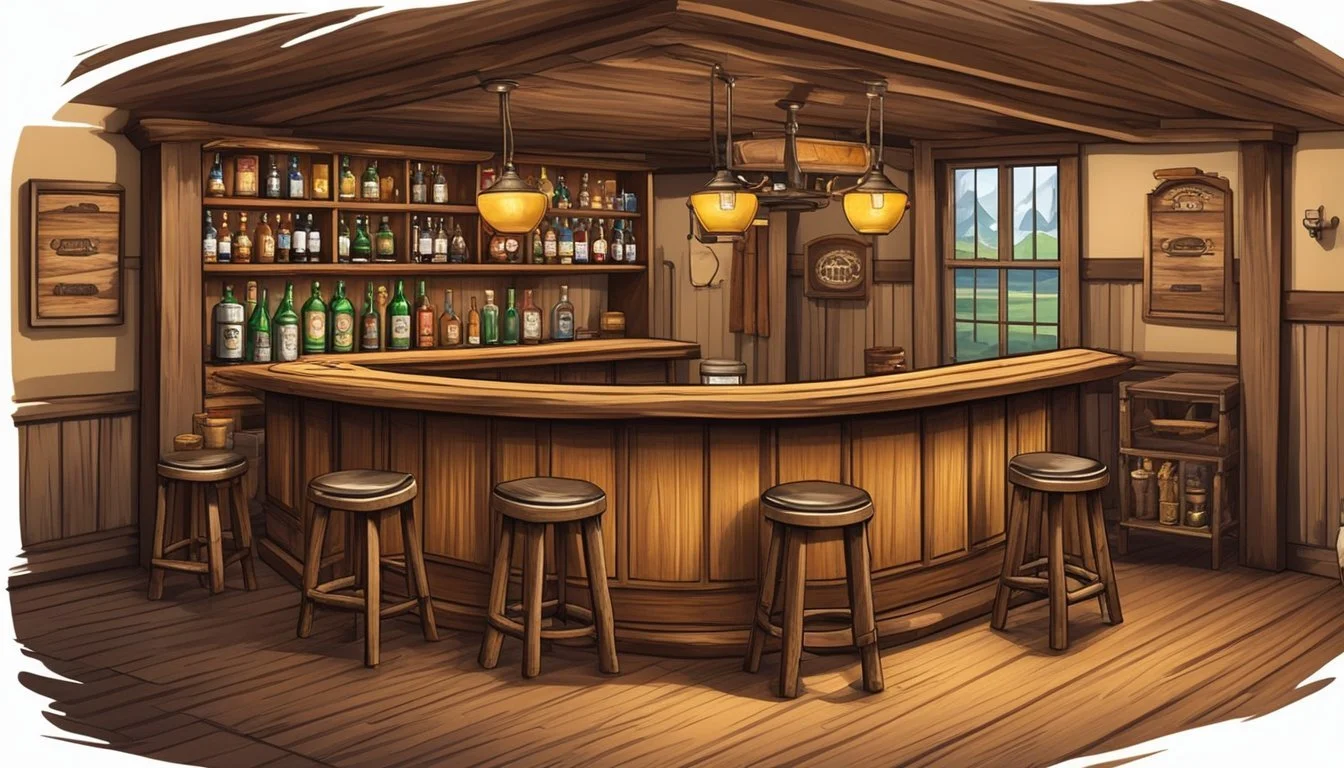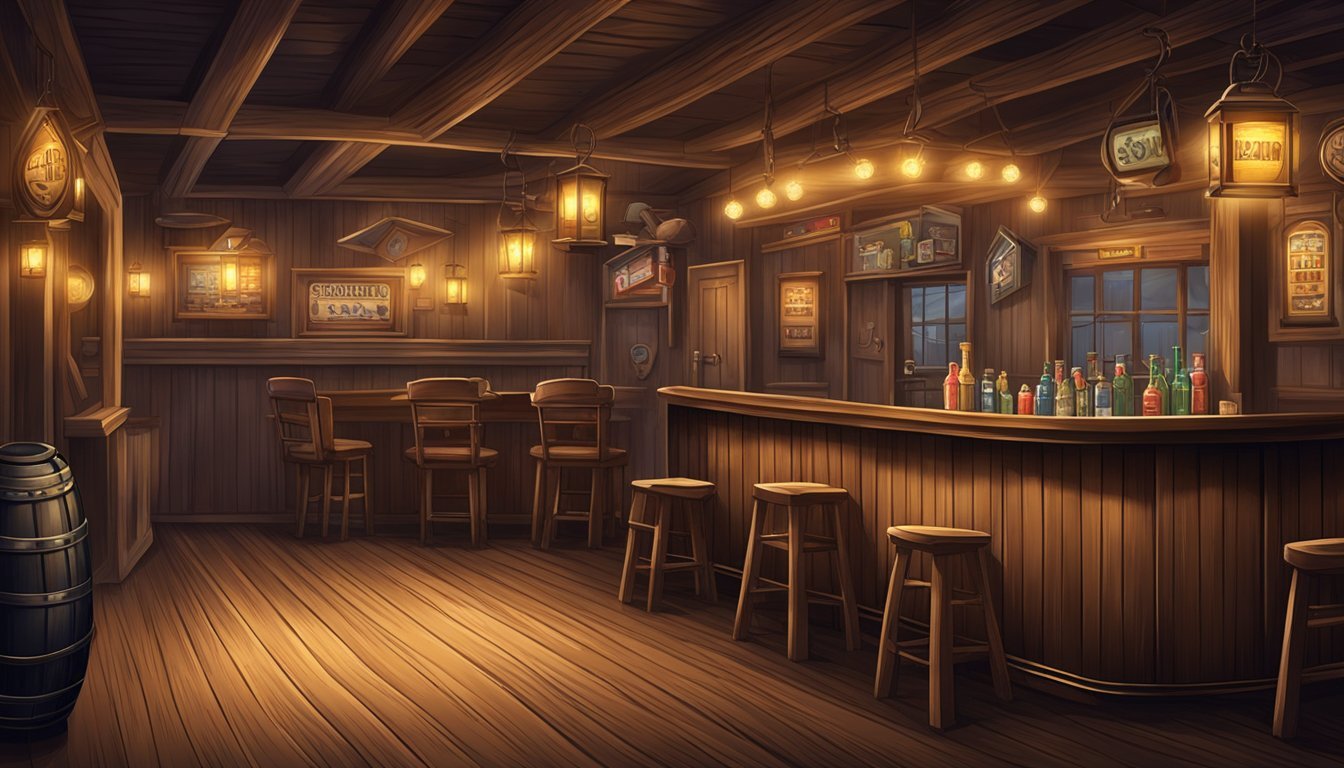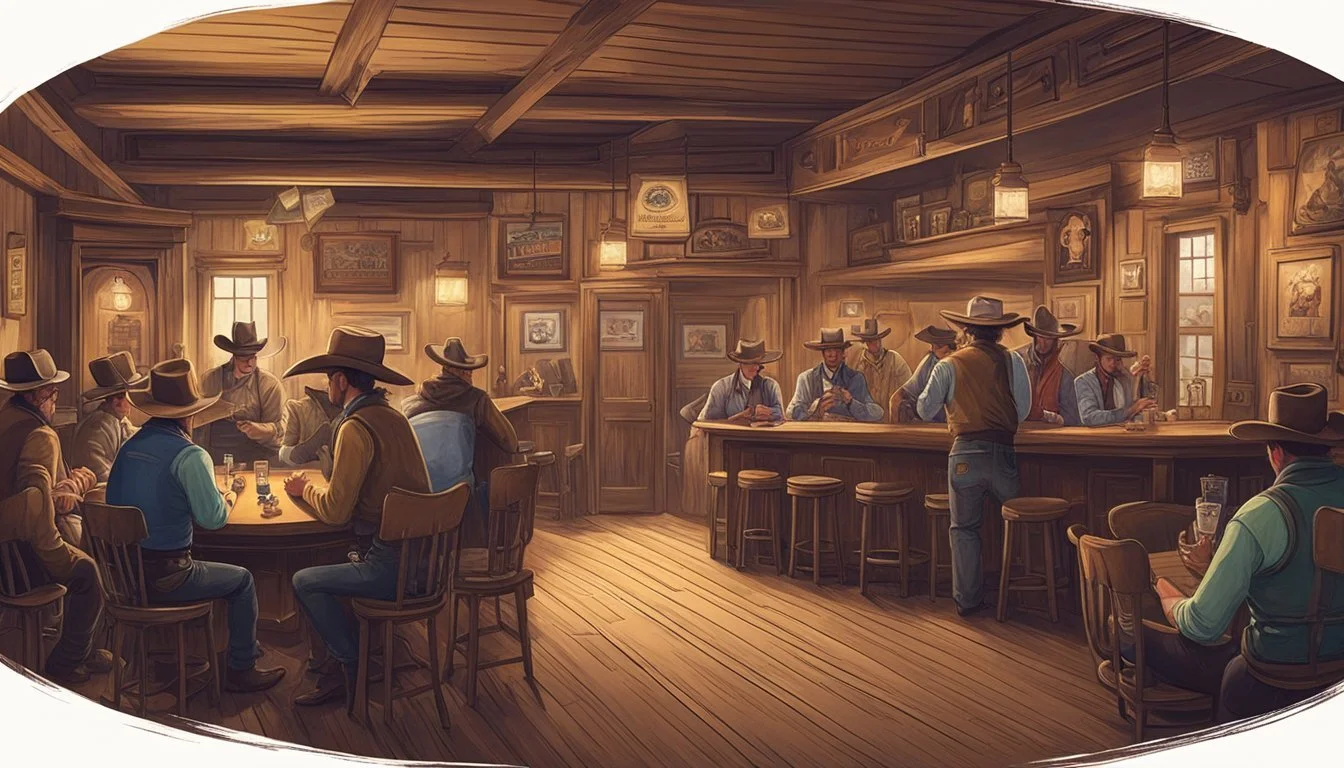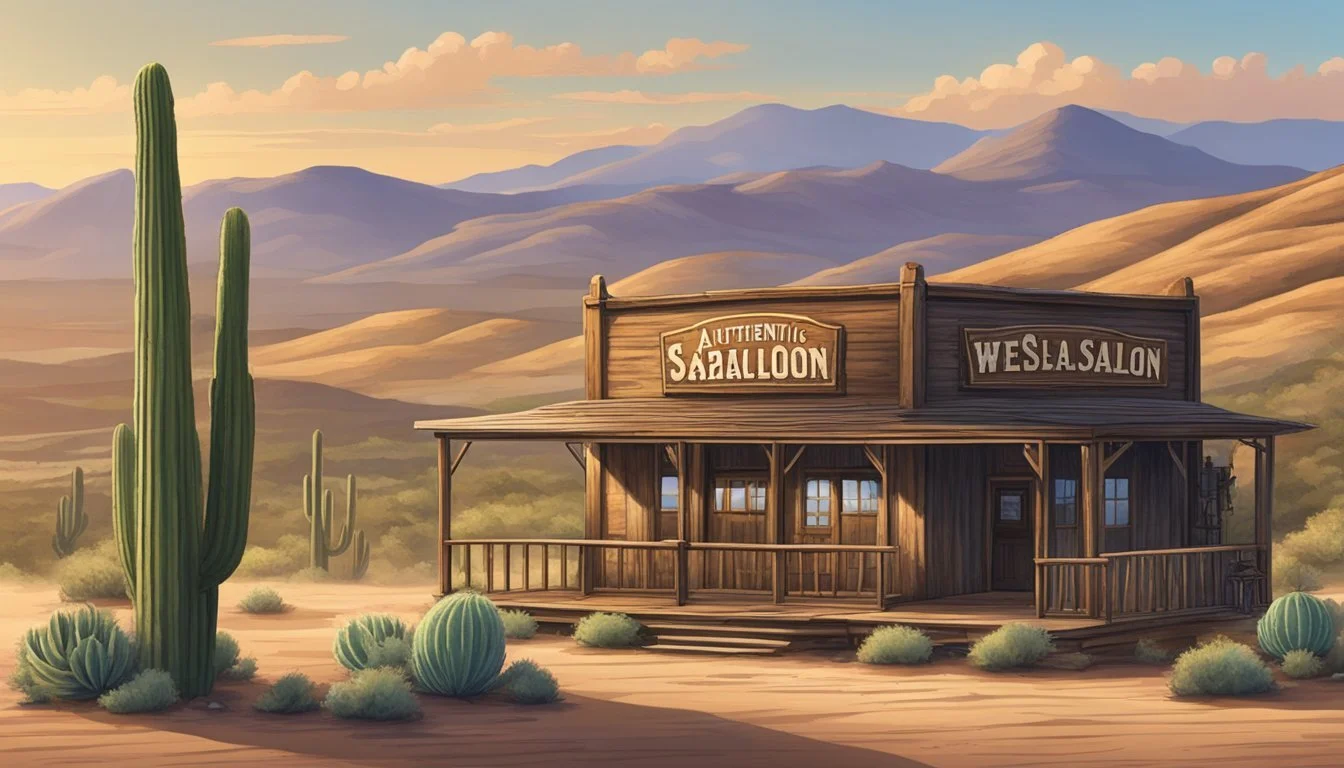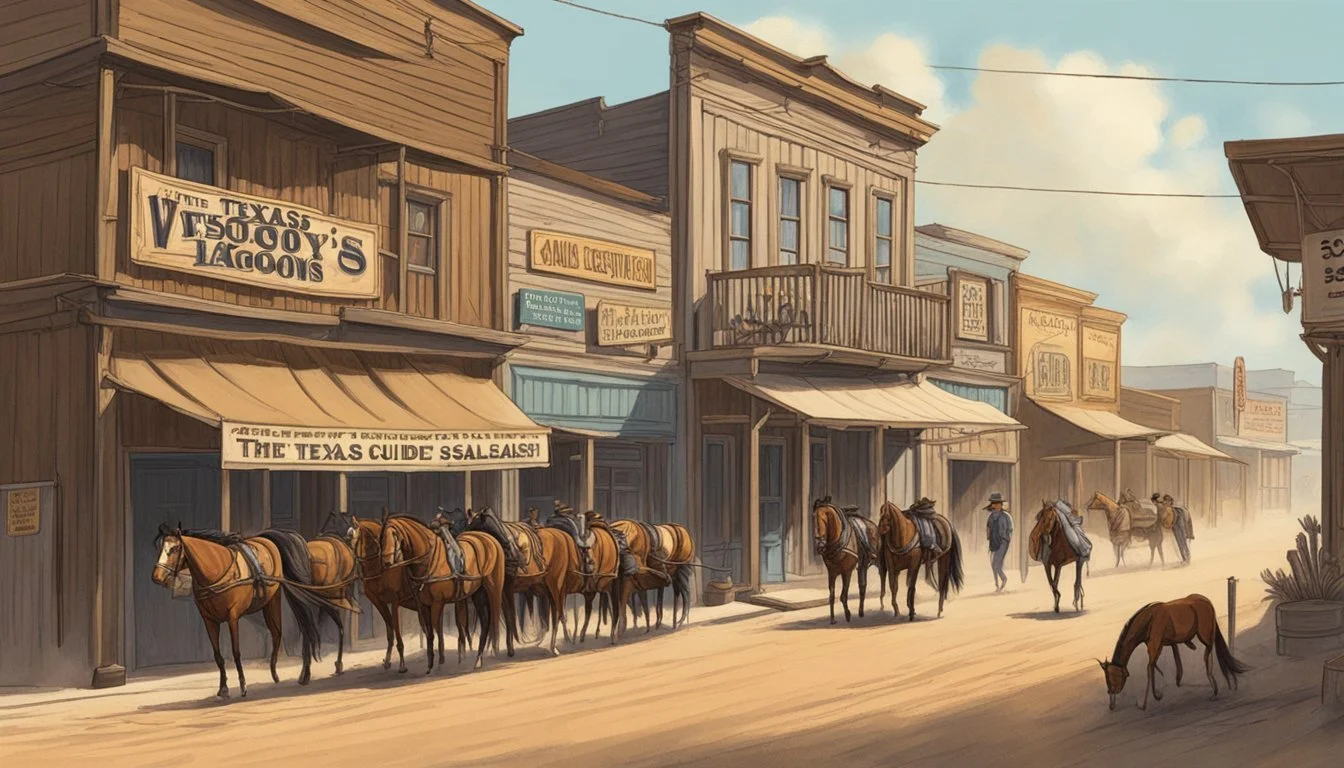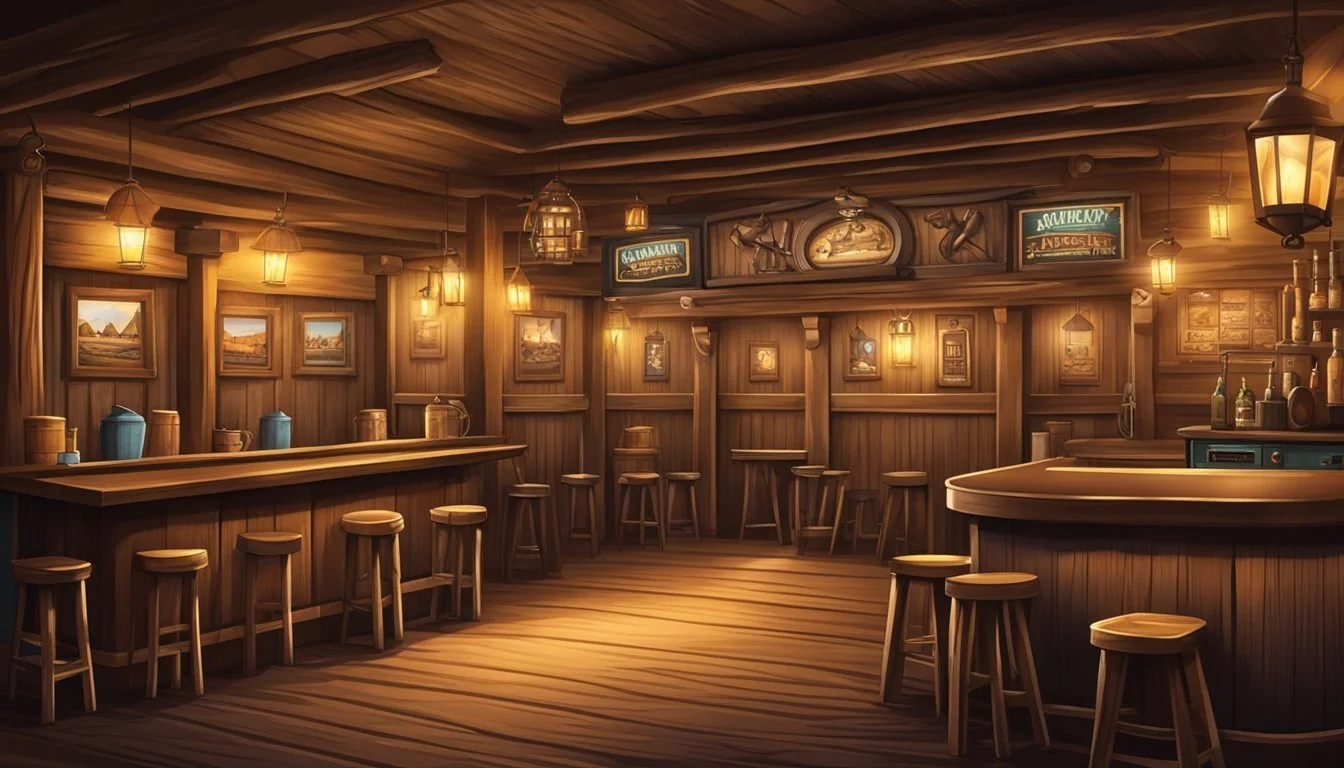The Texas Cowboy's Guide to Authentic Western Saloons
Discovering Timeless Charm
As the embodiment of Western heritage, Texas stands as a historical beacon, echoing the days when cowboys roamed the open range. An integral part of this heritage are the Western saloons, which have been central to cowboy culture since the state's frontier days. These establishments were not just watering holes but the social hubs of their communities, where cowboys, miners, fur trappers, and gamblers gathered.
In the heart of the Lone Star State, one can still find saloons that maintain the rugged spirit of the old West. These authentic Western saloons offer a tantalizing glimpse into the past, with their rich atmospheres steeped in history. It's a place where visitors can still witness the traditional Texas two-stepping, indulge in rich Texan cuisine, or partake in a historic cattle drive at locations like the Fort Worth Stockyards.
A visit to an authentic Western saloon in Texas is more than a simple outing; it's an immersion into a way of life that defined the American frontier. Each saloon tells a story, a narrative rich with the lore of outlaws and lawmen, the clinking of poker chips, and the timeless tunes from a honky-tonk piano. They offer a unique opportunity to experience Western camaraderie and understand why these establishments were and continue to be, a cornerstone of cowboy culture.
History and Evolution of Western Saloons
Western saloons are pivotal in the narrative of the American West, evolving from rudimentary drinking establishments to cultural icons synonymous with the frontier spirit.
Origins of the Saloon
The forefather of the western saloon originated from early Mexican cantinas, a concept encountered by settlers and cowboys in the Southwest. Saloons quickly became integral to newly established towns, serving as social hubs where people could gather, share news, and seek entertainment.
Saloons of the Gold Rush
The Gold Rush era marked the proliferation of saloons, particularly in booming towns like Deadwood and Virginia City. They catered to a growing populace of miners and prospectors, providing a locus for relaxation and camaraderie amid the strenuous search for gold.
Notable Gold Rush Town Saloons Crystal Palace Saloon - Tombstone, AZ Long Branch Saloon - Dodge City, KS
Notable Historical Saloons
Several saloons stand out in history for their association with legendary figures like Wyatt Earp and pivotal events of the Old West.
The White Elephant in Texas boasted a reputation that drew cowboys and outlaws alike.
Silver Dollar Saloon in Colorado gained fame for its patrons and role in local lore.
Each iconic establishment contributed to the enduring legacy of the rugged American frontier.
Geography of Western Saloons
Western saloons are an integral part of the cowboy culture, symbolizing the expansion and rugged social life of the American frontier. These establishments were not just places of leisure; they played a pivotal role in the development of communities, providing a gathering spot for locals and travelers alike.
Saloons of Texas
Texas was home to many iconic saloons that catered to cowboys, miners, and settlers. Towns like Bandera, known as the "Cowboy Capital of the World," and San Antonio, with its rich history including the San Jacinto battle, featured saloons that were central to their communities. In West Texas, the saloon served as a multifunctional space for socializing, conducting business, and entertainment.
Fort Worth's Drinking Heritage
Fort Worth was a significant stop for cattle drovers, and the city's saloons are famed for their role in its "Hell's Half Acre" district. The White Elephant Saloon in Fort Worth is a notable example—once a popular meeting place for gamblers and outlaws during the late 19th century. Today, the city retains a historic charm that echoes its past.
California's Legendary Watering Holes
California's saloons have a history that is as rich as its gold rush. San Francisco was the hub of numerous famed establishments, while the saloons of Virginia City became legends in their own right. As miners flocked to the Sierra Nevada Mountains, saloons became community hubs, often the first stop for hopeful prospectors.
Saloons Across the American Frontier
From the deserts of Idaho to the plains of Texas, saloons dotted the landscape. These establishments often sprang up even before schools and churches, as seen in burgeoning towns like Pendleton, Oregon. They varied from simple tents to grand wooden structures and were intrinsic to the cultural geography of the West.
Architecture and Style
In Texas's authentic western saloons, architecture and style are integral to delivering a genuine cowboy experience. These establishments are steeped in history and carefully preserve the visual aesthetics of their 19th-century origins.
Design Elements of Saloons
The classic western saloon is characterized by a distinctive facade that often features a broad, wooden front porch with support posts, leading to the establishment's entrance marked by swing doors. It's common for saloons to have flat-fronted or faux-fronted designs, an architectural style meant to project an impression of stability and permanence.
Key design elements include:
Timber Framing: Structures predominantly built from wood.
False Fronts: Elevated facades that make buildings appear larger.
Porch Overhangs: Providing shade and a place for horses.
Large Glass Windows: Often adorned with painted lettering.
Iconic Saloon Interiors
Upon swinging open the saloon doors, patrons are usually met with a long, polished wooden bar that spans the length of the room, often backed by an ornate mirror stretching across the back wall.
Some of the saloons, including the famous Crystal Palace in Tombstone, Arizona, flaunted not just extensive woodwork but also elaborate crystal fixtures, which included chandeliers that would capture and reflect lamplight, creating a glittering ambiance. Other interior elements consist of:
Pressed Tin Ceilings: Reflecting wealth and adding grandeur.
Brass Railings: Elegantly lining the bar and balconies.
Artwork: Portraying iconic Western scenes or notable figures.
Wallpaper or Painted Frescos: Adding to the artistic flair.
The interiors were purposefully designed to offer a welcoming space for socialization, often doubling as community hubs where news was exchanged, and plans were made. They crucially balanced function with style, providing a backdrop that resonated with the ruggedness and romance associated with the era of cowboys and outlaws.
Saloons in Culture
Western saloons have left an indelible mark on various aspects of culture, particularly in the realms of music, dance, and entertainment. The imagery and atmosphere of these establishments have influenced country music and have been immortalized in films and television shows, showcasing the rich history of the American frontier.
Influence on Music and Dance
Western saloons played a pivotal role in the evolution of country music. They served as venues for live music performances, where musicians blended folk tunes with new styles, giving rise to the honky-tonk sound characterized by its upbeat rhythms and twangy guitar play. Songs often discussed themes of love, hardship, and the rowdy saloon lifestyle, which resonated with many during the late 19th and early 20th centuries. Line dances and square dances were also common features, with patrons stepping and swinging to the sound of fiddles and banjos.
Music: Country music, live band performances
Dance: Line dancing, square dancing
Western Saloons in Film and TV
Saloons have frequently been depicted in film and TV, where they are portrayed as hubs of social activity and drama in cowboy-centric narratives. They are settings where plotlines unfold—showdowns, romances, and brawls. Prominent examples include classics like "Gunsmoke" and "Bonanza" where saloons are central to many episodes. The architecture and atmosphere of saloons, from the swinging wooden doors to the bar counters and dim lighting, have become visual shorthand for the Wild West era in both historical and fictional contexts.
Film & TV: Central settings for social activity
Books: Inspiration for scenes and settings in Western literature
The Saloon Business
The saloon was a cornerstone of economic and social life in the Old West. It served as a hub where business, socialization, and tourism intersected.
Economics of Saloons
The saloon industry was a booming facet of the Old West economy. In well-traveled towns such as Fort Worth, Texas, the number of saloons proliferated, reaching 60 establishments by 1883. Entry fees, sale of drinks, and other services like gambling and entertainment were significant income sources. A well-run saloon's business model included diversifying offerings, which might range from serving as an impromptu restaurant to organizing boxing matches.
Revenues: The primary revenue for saloons came from selling alcoholic beverages.
Expenses: Costs included liquor procurement, employee salaries, and establishment maintenance.
Saloons often acted as informal banks, extending credit to patrons, which tied them further to the local economy.
Saloons as Social Clubs
Saloon proprietors capitalized on the human need for social interaction. They became the unofficial social clubs of their time, attracting not only the working class like cowboys and miners, but also occasionally governors and local officials. Daily activities such as card games, billiards, and dances forged a sense of community, while free-flowing drink facilitated sociability and networking.
Events: Saloons would advertise and host special events to draw in larger crowds.
Membership: Some establishments created a membership model, offering exclusivity and special services to members.
These venues were integral in shaping social norms and culture in the burgeoning towns of the West.
Conservation and Tourism
Conservation efforts have helped to preserve the history of these iconic establishments for tourism and educational purposes. The Buckhorn Saloon and Texas Ranger Museum in San Antonio showcases over 130 years of saloon history in Texas. Visitors are drawn to these sites not just to sip a drink, but to immerse themselves in the authentic atmosphere of the Old West.
Museums: Former saloons converted into museums celebrate the social heritage of the region.
Tours: Historical tours of former saloon sites engage tourism, catalyzing local economies.
These conservation efforts ensure that the storied past of the cowboy and the Western saloon is not lost to history, promoting an understanding and appreciation of the Wild West's cultural legacy.
Cowboy Life and Saloons
In the Old West, saloons were more than just drinking establishments; they served as vital social hubs for cowboys who spent much of their time on remote cattle ranches. These locales not only offered respite and recreation but also helped shape the infamous cowboy culture.
The Role of Saloons in Cowboy Culture
Saloons often sprang up in burgeoning towns, immediately becoming a cornerstone of cowboy life. They functioned as multifaceted gathering spaces where cowboys could negotiate cattle sales, seek employment as wranglers, or simply exchange news. These establishments were typically the first buildings to dot the frontier landscape, symbolizing the emergence of community in the untamed West.
Gambling and Recreation
The allure of gambling was omnipresent in these western saloons, with games like poker and faro becoming legendary pastimes. Cowboys, known for their hard work and isolation on the range, would flock to saloons to unwind, play cards, and place bets, hoping to earn quick money or merely seeking entertainment to break the monotony of ranch life.
Popular Gambling Games:
Poker
Faro
Cowboys and Cattle Ranches
Cattle ranches were the economic backbone of the Old West, with the saloon serving as a pivotal anchor for social interaction. Cowboys spent their days on horseback, herding and managing livestock, while evenings were often spent in the local saloon; it was here that they could relax and revel in the camaraderie of their fellow cattle handlers. The saloon was an informal extension of ranch life, where the dusty and weary could find solace and community.
Cowboy Activities in Saloons:
Seeking employment
Relaxing after a day of ranch work
Bonding with peers over shared hardships and triumphs
Food and Beverage
In Texas, saloons play a pivotal role in reflecting the state's rich cowboy heritage, especially through their unique offerings of food and drinks. Here, one can not only savor the robust flavors of traditional western fare but also enjoy a special selection of signature beverages that evoke the spirit of the Old West.
Signature Drinks of the West
Whiskey reigns supreme in the world of Texan saloons as the quintessential distilled spirit associated with cowboys and the untamed frontiers. Patrons can find a wide range of whiskey options, from well-aged single malts to local rye whiskies. Saloons often boast original cocktail recipes that honor this legacy, with creative names and ingredients that nod to cowboy culture.
Classic Cocktails:
Old Fashioned
Whiskey Sour
Sarsaparilla-based drinks
Saloons and the Food Scene
Saloons in Texas offer an authentic culinary journey back to the days of cowboys and cattle drives with menus featuring hearty and satisfying foods. Steak and burgers are staples, often cooked over an open flame and served with sides like nachos—a crowd-pleaser with melted cheese and jalapeños.
Popular Dishes:
Ribeye Steak (What wine goes well with ribeye steak?): Chargrilled to perfection
Texan Burger: Topped with crispy onions and barbecue sauce
Loaded Nachos: Piled high with beef, cheese, and fixings
Prohibition's Impact on Saloons
The era of Prohibition had a profound impact on saloons, both in Texas and across America. Alcohol, the lifeblood of these establishments, was banned, leading to a rise in speakeasies and illicit spirits. Post-Prohibition, many saloons in Texas revived their traditions, re-establishing themselves as hubs of community and culture, where a drink is more than just beverage—it's a symbol of freedom and Western resilience.
Entertainment and Leisure
The essence of the authentic Texan cowboy saloon experience is not just in its decor but also in the vibrant entertainment and leisure activities it offers. Visitors can immerse themselves in the rich cultural tapestry through live music and various gaming activities integral to the Western saloon scene.
Live Music and Performances
In Texas cowboy saloons, live music is the heartbeat of the night. Traditional genres such as country, blues, and folk are staples, often creating a lively atmosphere that encourages dancing. The prominence of dance halls attached to these saloons provides ample space for both impromptu and organized dance events. Patrons can expect:
Weekly schedules of live bands or solo performers
Open dance floors catering to line dancing, two-stepping, and more
Gambling and Gaming Activities
Saloons in Texas are typically furnished with various entertainment fixtures. Gambling, once a hallmark of Wild West leisure, continues in a legal and moderated form, bringing a nostalgic edge to these historic establishments. Patrons might find:
Pool tables for casual play or competitive matches
Card tables for games like poker, maintaining the saloon's old-time gambling spirit
Outlaws and Lawmen
In the historic saloons of Texas, one might encounter tales as rich as the whiskey that flowed through them. These were places where the paths of famous outlaws and steadfast lawmen often crossed, each forging their own legend in the Wild West.
Famous Outlaws of the Saloons
Many notorious outlaws frequented the saloons of Texas, which served as informal hubs for gambling and exchanging news. Jesse James, known for his daring bank and train robberies, was rumored to have patronized these establishments to lay low between heists. Similarly, Billy the Kid left his mark on these saloons, his youthful notoriety and gunfighting skills the topic of whispered conversations around the poker tables. Here's a list of such outlaws and their associated saloons:
Jesse James: Known to be associated with various saloons as a haven.
Billy the Kid: Regularly visited saloons in his infamous haunts.
Lawmen and the Saloons
Saloons were not just shelters for fugitives but also served as the unofficial offices for lawmen. Wild Bill Hickok, a celebrated lawman and gunslinger, not only upheld the law but also became a legend within these walls. Saloons were often the stage for gunfights and confrontations, the most famous being the O.K. Corral, where lawmen faced off against those living outside the law. Key lawmen of the era included:
Wild Bill Hickok: His presence in saloons was noted for maintaining order.
O.K. Corral: The site of the infamous gunfight involving lawmen Earp brothers and Doc Holliday.
Notable Saloons Today
In today’s pursuit of the authentic Old West experience, a number of saloons stand out. They offer a glimpse into the past with their rich histories and provide a modern-day space for entertainment and camaraderie.
Preserved Historic Saloons
Bucket of Blood Saloon (Virginia City, Nevada) - Steeped in Wild West lore, this saloon gives patrons a taste of the past with its name recalling the often rowdy and violent atmosphere of the era.
Saloon No. 10 (Deadwood, South Dakota) - Known for a vast selection of bourbon and as the site where Wild Bill Hickok met his fate, this saloon maintains its 19th-century charm and historical significance.
Modern-Day Saloon Experience
Million Dollar Cowboy Bar (Jackson, Wyoming) - Not only does it serve contemporary western delights, but it also provides a space for locals and tourists to enjoy live country music.
Pioneer Saloon (Goodsprings, Nevada) - Embracing its century-long history, the Pioneer offers a unique blend of the traditional saloon atmosphere with modern comforts and hospitality.
Cowboy Gear and Apparel
In Texas, the attire of a cowboy is both a functional wardrobe and a statement of style. From the iconic cowboy boots to the indomitable Stetson hat, each piece serves a purpose while offering a nod to the Lone Star State's rich history.
From Boots to Hats – Cowboy Fashion
Cowboy boots are more than just footwear; they're a fusion of function and flair. Crafted with high-quality leather, the design includes a tall boot shaft to protect the shins and a distinct heel to keep feet secure in stirrups. Stitching isn't solely decorative; it reinforces the boot's structure. The pointed toe helps a cowboy effortlessly slide into the saddle. Top brands like Lucchese and Ariat offer both classic and modern styles.
The Texas Cowboy's choice in jeans is historically Wrangler, renowned for durability and comfort. Authentic cowboy jeans are designed with reinforced fabric and a fit that accommodates the rigorous demands of ranch life.
Shirts range from practical cotton workwear to the iconic pearl-snap Western shirt, often featuring bold patterns and a sharp, pointed collar. As for hats, the cowboy’s Stetson is not just a stylish piece but a defense against the harsh Texas climate, shading the eyes and face.
Belts and Buckles complete the look, often personalized with intricate designs and the cowboy's initials. These accessories are not just ornamental but reflective of a cowboy's accomplishments and heritage.
Saloons as Retail Spaces
Many saloons in Texas double as retail spaces, providing patrons with a place to purchase authentic cowboy gear. They offer a blend of modern and traditional western apparel where one might find a rack laden with Schaefer Outfitter garments beside contemporary western wear.
In such saloons, customers can procure everything from gloves to hats, and often these items are displayed alongside cowboy firearms and other accoutrements, making the shopping experience one with a taste of the old Wild West.
These spaces are not just for buying; they're where cowboys can exchange tips on where to find the best gear and how to take care of their apparel, ensuring they look sharp and ready for both work and leisure in the Texan outdoors.
Saloons and Community
Saloons played an integral role in the social fabric of frontier towns, acting as converging points for community life and local culture.
Saloons as Community Hubs
In the heyday of the frontier town, saloons were more than just establishments for drinking; they were vital community hubs. These venues functioned as impromptu town halls, where cowboys, travelers, and local residents gathered not only to enjoy a drink but also to exchange news, conduct informal business, and connect over shared experiences. Saloons provided a space for essential communal interactions, especially in burgeoning towns where formal institutions had yet to be established.
Social Clubs: These gatherings often evolved into organized social clubs, with saloons providing a venue for meetings.
Dance Halls: Many saloons doubled as dance halls, invigorating community life with music and celebration.
Saloons and Local Traditions
Saloons were instrumental in shaping and maintaining local traditions. They were cultural melting pots where folklore and customs were shared and preserved.
Festivities: Saloons hosted community events, including dances, live music, and even theatrical performances.
Tradition Bearers: Bartenders and regulars often took on the role of tradition bearers, passing down stories and customs integral to the identity of the community.
By serving as these communal linchpins, saloons helped solidify the sense of community and shared identity characteristic of the Old West.
Environmental Concerns
In the context of Texas's rich western heritage, environmental conservation within saloons is often overlooked. This section discusses both the historical and modern efforts towards sustainable practices in these iconic establishments.
Saloons and Conservation
Conservation efforts within the realm of historical saloons are essential in preserving the natural environment. These establishments have the potential to impact local ecosystems through the resources they consume. As remnants of the Wild West, the responsibility falls on current managers to maintain the environmental integrity of these areas. They should ensure that operations within these saloons do not threaten local wildlife or natural landscapes.
Resource Management: Use of sustainable materials in renovations and daily operations.
Waste Reduction: Implementation of recycling and composting programs.
Sustainable Practices in Saloon Management
Modern saloon owners and managers can undertake several sustainable practices to minimize their environmental footprint. The focus is on reducing energy consumption, minimizing waste, and utilizing sustainable resources.
Energy Efficiency: Upgrades to lighting, heating, and cooling systems to reduce energy utilization.
Sourcing Locally: Procuring food, spirits, and materials from local providers to lessen transportation emissions.
By integrating these practices, saloons can not only honor their historic past but also secure a healthier environment for future generations.
Global Influence
The allure and iconography of Texas's cowboy culture, especially as depicted by authentic western saloons, extend far beyond the American Southwest to leave a global footprint.
Western Saloons Around the World
One can find the spirit of western saloons influencing locales worldwide. These establishments adopt the thematic elements of the American frontier, integrating a mix of rustic decor, traditional western music, and a menu often featuring hearty Texan fare. Germany, for instance, has embraced the western saloon theme within its borders, melding their historical tavern culture with the Old West aesthetic. Here, patrons can experience a slice of Americana while enjoying a unique fusion of local and Texan hospitality.
Saloons in Sports and Recreation
Saloons on the Texas frontier played pivotal roles in the social lives of cowboys, often serving as multifunctional spaces where sports and recreation were as common as drinking and camaraderie.
Saloons as Venues for Sports Events
Historically, saloons were more than just places for drinking, they played host to a variety of local sports events. Patrons could witness or participate in activities, sometimes with an impromptu nature. Events like boxing matches and wrestling were often featured, drawing a crowd hungry for entertainment in an era devoid of today's digital diversions.
Boxing Matches: Saloons frequently cleared space for a ring where fighters would compete, betting was common.
Wrestling: Wrestling bouts were another form of competitive sport frequently organized in these establishments.
Saloons and Recreational Activities
Saloons offered numerous recreational activities beyond just sports events. These activities fostered social interactions and served as a pastime for patrons.
Card Games: Poker and other card games were staples, often associated with gambling.
Billiards: Billiard tables were common fixtures, providing a relaxed, competitive pastime.
Music and Dance: Live music and space for dancing offered a recreational outlet for townsfolk.
Saloons were centers of social interaction where cowboys and other locals could engage in a range of sports and recreational activities, all under one roof.
The Future of Saloons
As the saloon industry moves forward, it integrates innovative practices while ensuring the storied past of such establishments is not forgotten. The result is a nuanced evolution that honors tradition and adapts to modernity.
Innovation in the Saloon Industry
The saloon industry has always been a reflection of the times, and as it looks to the future, it is set to embrace new technologies and customer experiences. Smart technology might be incorporated for more efficient beverage service and payment systems. Saloons may also offer virtual reality experiences that transport patrons to the historic Wild West. Another possibility is the integration of app-based loyalty programs, incentivizing regulars to keep coming back. Patrons can expect a seamless blend of the old and new, offering atmospheric charm bolstered by technological convenience.
Preservation of the Saloon Legacy
Preservationists and saloon enthusiasts understand the importance of maintaining the authentic feel of these historic watering holes. Efforts to preserve them lean on meticulous restoration and adherence to historical accuracy. For example, the Buckhorn Saloon in San Antonio showcases Texas history and fosters a sense of community built on its 130-year-old foundation. Here's an approach to understanding how the legacy is preserved:
Architectural Restoration: Using period-specific materials and techniques to maintain structural authenticity.
Historic Memorabilia: Exhibiting photographs, artifacts, and decor consistent with the saloon’s era.
Telling Stories: Educating visitors about the saloon's role in frontier life and its impact on local culture.
Thoroughly documented histories and engaging storytelling ensure that the spirit of the Old West does not fade, even as new chapters are written into the narrative of these storied establishments.
Resources and Further Reading
For those interested in delving deeper into the heritage of Texas cowboys and western saloons, a variety of resources are available, encompassing books, articles, and educational materials.
Books:
"The Cowboys of the Wild West" by Walter S. Durham provides an insightful historical perspective on the cowboy lifestyle.
"Saloons of the American West: An Illustrated Chronicle" by Richard Erdoes offers a vivid look into the historical saloons that dotted the frontier.
Articles:
Scholars can access "The Journal of the West" for peer-reviewed articles on western history, including the development of saloons.
"Texas Highways," the official travel magazine of Texas, frequently publishes features on historical sites and experiences.
Educational Resources:
The Texas Ranger Museum in San Antonio, mentioned in the search results, is an excellent source of historical artifacts and exhibits.
The Stockyards National Historic District in Fort Worth conducts daily cattle drives and has numerous resources to learn about the cowboy culture.
To further explore Texas's western heritage, one might consider visiting Pioneer Plaza in Dallas to view the impressive bronze monument of the cattle drive. Additionally, the Fort Worth Stockyards offers a firsthand experience of the Old West through its living history exhibits.
Readers should consult the local libraries and Texas historical society websites for more comprehensive directories on the Texan cowboy experience.
Conclusion
Western Saloons hold a treasured spot in Texas history, serving as cultural landmarks where cowboys once frequented. Today, these establishments continue to honor that legacy, with Texans and visitors alike relishing an authentic Western experience.
Saloon culture in Texas merges the past and the present. Places like The Esquire Tavern in San Antonio weave historical ambiance with contemporary tastes. Meanwhile, the Buckhorn Saloon and Texas Ranger Museum offers a unique combination where patrons can sip on a cold drink while being surrounded by Texas history.
The spirit of the Texas Cowboy endures within these saloons, with their tenacious character embedded in every Western-themed event, from Texas two-stepping to lively barbecue gatherings. Saloons exemplify the rugged charm intrinsic to the cowboy image.
Authentic Western saloons not only offer a sense of nostalgia but also ensure the survival of the cowboy ethos. These spaces provide educational value and foster community spirit, a testament to the enduring allure of cowboy culture.
In representing the frontier times, they contribute significantly to the authentic Texan narrative. Therefore, saloons are not just old structures; they are living museums, echoing stories of the past while creating new memories. They stand as proud emblems of a heritage that continues to shape Texas identity.

